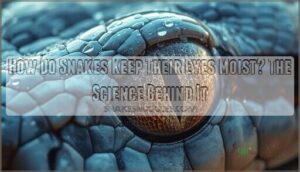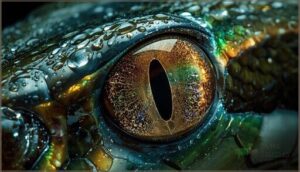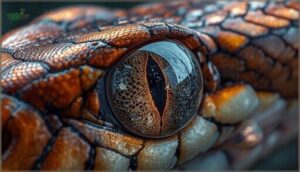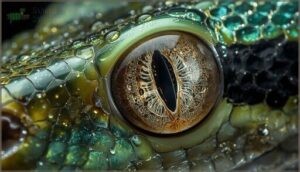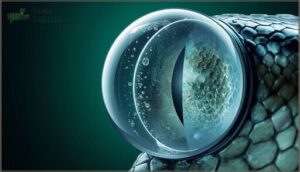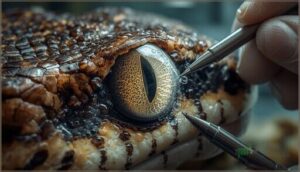This site is supported by our readers. We may earn a commission, at no cost to you, if you purchase through links.
Snakes don’t blink. They can’t shed a tear, rub their eyes, or close them to protect against dust and debris. Yet their eyes remain perpetually moist and functional—a feat that seems to defy the basic requirements of eye health.
The secret lies in a unique anatomical adaptation called the spectacle, a transparent scale that permanently covers each eye like a built-in contact lens. Beneath this protective barrier, snakes maintain a complex moisture regulation system involving specialized glands, fluid-filled spaces, and drainage channels that work continuously without any conscious effort.
Understanding how snakes keep their eyes moist reveals an elegant solution to a problem most animals solve through blinking—and explains why proper humidity matters so much in captive snake care.
Table Of Contents
- Key Takeaways
- How Do Snakes Keep Their Eyes Moist?
- Snake Eye Anatomy and Protective Adaptations
- Lacrimal Fluid Production in Snakes
- Drainage and Renewal Mechanisms
- Environmental and Behavioral Adaptations
- Common Eye Health Issues in Snakes
- Frequently Asked Questions (FAQs)
- How do snakes keep their eyes moist?
- Why do snakes sleep with their eyes open?
- How do snakes use their eyes?
- Why do snakes have eyelids?
- Why do snakes have transparent eyes?
- Do snakes lubricate their eyes?
- How do snakes eyes not dry out?
- How do snakes lubricate their eyes?
- How do snakes keep their eyes clean?
- Are snakes’ eyes wet?
- Conclusion
Key Takeaways
- Snakes maintain eye moisture through a transparent, fused scale called the spectacle (brille) that permanently covers each eye, eliminating the need for blinking while providing continuous protection against debris and physical damage.
- The Harderian gland continuously produces specialized tear fluid that fills the subspectacular space beneath the spectacle, then drains directly into the mouth through a unique lacrimal duct system rather than into the nasal cavity like mammals.
- The spectacle sheds completely during ecdysis (skin shedding), serving as a self-renewal mechanism that removes surface damage and restores optical clarity—a process that occurs 4-12 times yearly in young snakes and less frequently in adults.
- Proper humidity levels (50-80% depending on species) are critical for captive snake eye health, as insufficient moisture can cause retained spectacles that lead to corneal damage, infections, and potentially permanent vision loss.
How Do Snakes Keep Their Eyes Moist?
Snakes don’t blink, yet their eyes stay perfectly moist in environments that would leave ours dry and irritated. Their evolutionary solution involves a transparent shield, a specialized gland, and a drainage system you won’t find in most other animals.
Snakes keep their eyes moist without blinking through a transparent shield, specialized gland, and unique drainage system
Let’s examine the three core mechanisms that keep snake eyes hydrated without a single blink.
The Role of The Spectacle (Brille)
Your snake’s eyes stay moist thanks to the spectacle—a transparent, fused scale that evolved when their burrowing ancestors needed constant eye protection underground. This outstanding brille fulfills multiple purposes:
- Shields the cornea from physical damage and debris
- Functions as a refractive surface with an index ≥ 1.5
- Filters harmful ultraviolet light in day-active species
- Varies in thickness (74-244 µm) based on habitat
- Maintains continuous moisture beneath its surface.
The snake’s eye also benefits from reduced blood flow patterns during threats, which helps improve vision.
Absence of Traditional Eyelids
Unlike mammals, you won’t see snakes with movable eyelids—they lost them millions of years ago during eyelid evolution. During embryonic development, their eyelids fused permanently to form the transparent spectacle covering snake eyes. This shift eliminated blinking entirely, which fundamentally changed how these reptiles maintain eye moisture and corneal health.
The spectacle function now manages all eye protection and retention tasks that traditional eyelids once performed, optimizing snake vision for survival. Snakes rely on their eye protection mechanism to keep their eyes safe and healthy.
Moisture Maintenance Without Blinking
Without blinking, you might wonder how snakes achieve reliable eye moisture and corneal health. The spectacle function relies on continuous tear production from the Harderian gland, which floods the subspectacular space with lubricating fluid.
This moisture regulation system drains through a specialized nasolacrimal duct into the mouth, ensuring constant eye hydration. It’s a passive yet remarkably efficient mechanism that maintains ideal reptile eye facts and snake eye anatomy for lifelong eye health.
Snake Eye Anatomy and Protective Adaptations
Snake eyes are built differently than yours, and those differences make all the difference regarding staying moist. Instead of blinking or producing tears the way mammals do, snakes rely on specialized anatomical structures that work together as a self-contained hydration system.
Let’s look at the key components that make this possible.
Structure and Function of The Spectacle
The transparent covering over your snake’s eyes, called the spectacle, is a marvel of evolutionary engineering. This fused scale ranges from 74 to 244 micrometers in thickness depending on species and habitat.
It functions as the primary refractive surface with an index of at least 1.5, replacing corneal function while providing continuous protection.
The spectacle’s triple-layered structure—outer keratin, vascular stroma, and inner epithelium—ensures both visual acuity and corneal protection.
The Subspectacular Space
Beneath the spectacle lies a fluid-filled chamber that’s essential for your snake’s eye function. This subspectacular space contains tear-like secretion that keeps everything running smoothly.
Here’s what makes this anatomy exceptional:
- The narrow gap between spectacle and cornea holds lacrimal fluid from the Harderian gland
- This subspectacular fluid lubricates continuously without blinking
- The lacrimal duct drains excess moisture directly into the mouth
- During spectacle shedding, fluid levels increase to separate old from new layers
Corneal Protection and Hydration
Your snake’s cornea stays healthy through a carefully engineered system that balances protection with hydration. The spectacle’s composition allows oxygen to diffuse through while blocking water loss, reducing evaporation by 40-60% compared to exposed corneas. This sealed environment maintains visual acuity even in harsh conditions.
Glandular secretions beneath the spectacle contain antimicrobial compounds that protect corneal health while stabilizing eye moisture levels, ensuring your snake’s vision remains sharp without traditional blinking mechanisms.
| Function | Mechanism | Benefit |
|---|---|---|
| Oxygen diffusion | Spectacle permeability | Facilitates corneal metabolism |
| Moisture retention | Subspectacular seal | Prevents desiccation |
| Antimicrobial protection | Glandular secretions | Reduces infection risk |
| Hydration stability | Controlled evaporation | Maintains ocular clarity |
Lacrimal Fluid Production in Snakes
You might wonder how a creature without eyelids keeps its eyes from drying out. The answer lies in a specialized gland that works behind the scenes, producing fluid much like your own tears.
Let’s look at how this moisture system functions to keep snake eyes healthy and clear.
Harderian Gland Function
Your snake’s eye health depends on a fascinating organ you’ve probably never heard of: the Harderian gland. Located deep in the orbital space behind each eye, this compound acinar gland acts as the primary tear production factory.
It secretes a specialized lacrimal fluid that flows through tiny ductules into the subspectacular space, continuously lubricating the spectacle and maintaining the clear snake vision essential for hunting and navigation.
Composition of Snake Tear Fluid
Think of tear fluid as a refined chemical cocktail protecting your snake’s eyes. The protein composition includes diverse molecules that stabilize the tear film and reduce evaporation. Electrolyte balance—sodium, chloride, and urea—maintains tear osmosis across the spectacle.
Lipid layers control moisture loss, while mucin functions provide lubrication and pathogen defense.
This complex blend ensures ideal eye health and prevents common eye problems in reptile health management.
Lubrication and Eye Health
When tear fluid circulation falters, your snake’s ocular surface health deteriorates rapidly. Proper lubrication prevents corneal hydration deficits that compromise spectacle function and vision clarity.
The tear fluid composition you learned about actively shields snake eyes from infection while facilitating smooth eye movement beneath the spectacle.
Maintaining eye moisture balance through adequate humidity directly bolsters reptile health, preventing common eye problems like retained spectacles and subspectacular infections in snake eye health management.
Drainage and Renewal Mechanisms
Keeping the eye moist isn’t just about producing fluid—it’s about managing where that fluid goes and ensuring the protective covering stays in peak condition.
Snakes use two complementary mechanisms to maintain eye health: a continuous drainage system that prevents fluid buildup, and a periodic renewal process that replaces the spectacle entirely.
Understanding how these systems work reveals just how well-adapted snake eyes are to their unique anatomy.
Lacrimal Duct Drainage to The Mouth
Unlike mammals that drain tears into the nasal cavity, your snake’s lacrimal system takes a different route. The lacrimal duct channels tear fluid directly into the oral cavity, near the vomeronasal organ opening.
This unique drainage pathway fulfills multiple functions:
- Lubricates the mouth to assist with swallowing prey
- Minimizes tear evaporation by maintaining a closed subspectacular space
- May boost chemical detection through the vomeronasal system
This mouth drainage mechanism keeps snake eyes properly hydrated while supporting other physiological needs.
Shedding of The Spectacle During Ecdysis
During ecdysis, your snake sheds the entire spectacle as one piece of its outer skin. You’ll notice a cloudy, bluish appearance beforehand—that’s old and new layers separating. This complete renewal removes surface damage and restores optical clarity.
Young snakes go through this process 4 to 12 times yearly, while adults shed less often.
| Phase | Visual Sign | Duration |
|---|---|---|
| Pre-shed | Milky opacity | Several days |
| Active shed | Skin peeling | Hours to 1 day |
| Post-shed | Clear spectacle | Immediate |
| Recovery | Normal vision | Within hours |
Restoration of Moisture Balance
Once the shedding cycle completes, your snake’s eye hydration system resets. Spectacle regeneration fully restores moisture regulation within two or more sheds if the old layer is successfully removed.
Blood flow increases during this renewal phase, delivering nutrients that maintain corneal health and prevent desiccation. You can support this natural eye care process by optimizing humidity levels and ensuring proper moisture retention throughout each cycle.
Environmental and Behavioral Adaptations
Snakes don’t rely on anatomy alone to keep their eyes moist. The environments they inhabit and the behaviors they’ve developed play equally important roles in maintaining proper ocular hydration.
From humidity levels in their natural habitats to specific moisture-seeking behaviors, these adaptations guarantee their eyes stay healthy across diverse ecosystems.
Impact of Humidity and Habitat
Across vastly different landscapes, humidity control shapes how effectively snakes maintain eye moisture and overall health. Your snake’s habitat adaptation directly influences the spectacle’s ability to retain water and prevent environmental stress.
- Desert adaptations: Arid-dwelling species conserve moisture through specialized tear film composition and thicker spectacles
- Tropical species: High-humidity reptile characteristics support continuous lacrimal fluid production
- Microclimate selection: Snakes seek humid burrows or vegetation to regulate spectacle hydration
- Captive care: Maintaining 70-80% humidity prevents retained eye caps in most species
- Moisture retention mechanisms: Habitat moisture levels determine snake eyes’ clarity and shedding success
Behavioral Strategies for Moisture Retention
Beyond passive environmental adaptation, you’ll observe that snakes actively manage spectacle moisture through targeted behaviors. Humidity seeking becomes pronounced before the shedding process begins—your snake may soak in water dishes or retreat to humid hides. Rubbing against rough surfaces provides spectacle cleaning, removing debris that compromises moisture regulation.
These behavioral strategies directly prevent retained spectacles and maintain ideal eye structure function without any blinking mechanism involvement.
Species-Specific Adaptations
Spectacle thickness reveals striking species variability across snake eye anatomy. Burrowing species—pipe snakes and blind snakes—possess spectacles reaching 244 μm, while arboreal forms measure just 74 μm.
Aquatic adaptations drive sturdy eye structure that withstands water pressure and debris. These burrowing features and aquatic modifications guarantee proper eye moisture retention without compromising visual function, demonstrating how snake eye adaptation fine-tunes reptile eye care mechanisms to habitat demands.
Common Eye Health Issues in Snakes
Even with their specialized moisture system, snakes can face eye problems when something disrupts the delicate balance. Retained spectacles and drainage issues are among the most common complications you’ll encounter as a keeper.
Recognizing early warning signs and knowing when to seek veterinary care can make the difference between a minor issue and a serious health concern.
Retained Spectacles and Their Risks
When retained eye caps accumulate, you’re looking at more than cosmetic trouble—this becomes a genuine health crisis. Spectacle retention often stems from low humidity or nutritional gaps, and corneal damage can follow if multiple layers build up.
Eye infections thrive beneath these stuck barriers, and improper removal risks complete spectacle avulsion or even panophthalmitis. Chronic shedding issues may ultimately steal your snake’s vision permanently.
Signs of Eye Moisture Problems
Vigilance is your best tool when spotting moisture retention issues and corneal damage in your snake. Watch for these signs of eye infection:
- Cloudy eyes that persist after shedding signal retained eye caps requiring immediate attention.
- Swollen or distended eyes indicate blocked drainage, often linked to infection.
- Rubbing behavior or discharge suggests vision problems demanding snake eye care.
Preventive Care and Veterinary Attention
Your snake’s eye health depends on proactive veterinary care and consistent habitat management. Schedule an initial exam within one week of acquisition and annual check-ups to monitor hydration and ocular conditions.
Maintain 50-60% humidity, provide abrasive shedding surfaces, and guarantee fresh water access.
When eye infections or retained spectacles occur, seek immediate veterinary intervention from a reptile veterinarian rather than attempting home removal.
Frequently Asked Questions (FAQs)
How do snakes keep their eyes moist?
Unlike mammals that blink, your serpent’s corneal health depends on a transparent scale called the brille.
Tear production from the Harderian gland continuously moisturizes the subspectacular space beneath this protective covering.
Why do snakes sleep with their eyes open?
You might wonder about snake sleep patterns since their eyes never close. Because snakes lack movable eyelids, they physically can’t shut their eyes—even during rest—making this anatomy of snake eyes truly unique evolutionarily.
How do snakes use their eyes?
How do predators strike with such accuracy? Snakes use their eyes to detect motion and track prey despite limited focal length adjustments.
Their eye structure and visual acuity vary by species, with some possessing depth perception for precise hunting.
Why do snakes have eyelids?
Actually, snakes don’t have traditional eyelids. During embryonic development, their eyelids fuse into a transparent spectacle—a protective scale covering the eye.
This adaptive trait shields against debris while maintaining constant vision in ground-dwelling environments.
Why do snakes have transparent eyes?
The transparent scale covering snake eyes, called the spectacle, evolved from fused eyelids in their fossorial ancestors.
This adaptation protects the eye continuously while maintaining clear vision for hunting and navigation.
Do snakes lubricate their eyes?
Yes, snakes lubricate their eyes through tear production by the Harderian gland. This lacrimal fluid continuously bathes the subspectacular space beneath the spectacle, maintaining corneal health and supporting clear snake vision without blinking.
How do snakes eyes not dry out?
Unlike creatures that blink frantically to ward off dryness, snakes rely on their spectacle—a fused, transparent scale—to lock in moisture. Continuous tear production beneath this brille maintains corneal hydration, ensuring ocular health without traditional eyelids.
How do snakes lubricate their eyes?
Snakes lubricate their eyes through tear production from the Harderian gland. This specialized gland secretes fluid into the subspectacular space beneath the spectacle, maintaining corneal health and ensuring proper eye moisture without traditional blinking.
How do snakes keep their eyes clean?
How do snakes keep their eyes clean? They rely on spectacle shedding during molting to remove debris and restore corneal health, while rubbing against surfaces helps with vision maintenance and overall ocular hygiene between sheds.
Are snakes’ eyes wet?
Technically, yes—the cornea stays bathed in tear fluid beneath the spectacle, maintaining ocular hydration.
This subspectacular moisture creates wet eye conditions essential for corneal wetness, even though the outer surface appears dry.
Conclusion
For creatures that never close their eyes, snakes have mastered the art of keeping them protected. Their spectacle-and-gland system answers how snakes keep their eyes moist without blinking—a solution more elegant than our tear-dependent method.
When you maintain proper humidity in captivity, you’re not just mimicking nature; you’re ensuring this ancient moisture system functions as evolution designed. The snake’s unblinking stare isn’t a vulnerability—it’s a proof of millions of years of refined adaptation.
- https://pmc.ncbi.nlm.nih.gov/articles/PMC10044692/
- https://www.sciencenordic.com/animals-biology-denmark/snakes-eyes-could-give-us-super-eyesight/1430322
- https://repository.naturalis.nl/document/555628
- https://reptilesmagazine.com/snake-with-retained-spectacle/
- https://en.wikipedia.org/wiki/Nictitating_membrane

